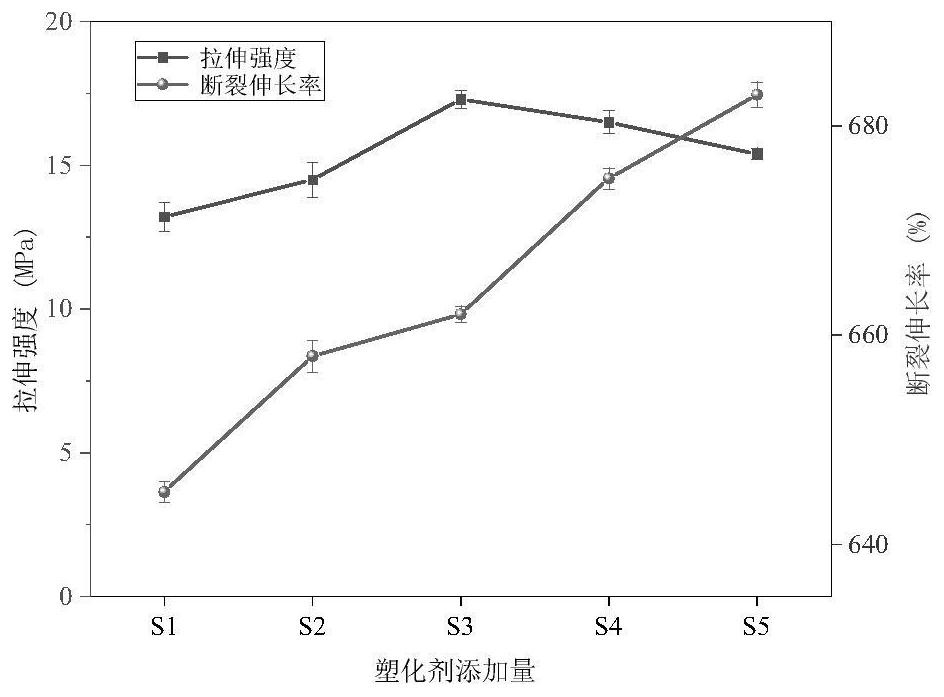Starch/cellulose/PBAT composite film and preparation method thereof
A composite film and cellulose technology, applied in the direction of grain processing, etc., can solve the problems of low strength, less filling, poor processing efficiency, etc., and achieve the effect of good processing performance, low cost, and reduced production cost
- Summary
- Abstract
- Description
- Claims
- Application Information
AI Technical Summary
Problems solved by technology
Method used
Image
Examples
Embodiment 1
[0047] The preparation method of the starch / cellulose / PBAT composite film of embodiment 1, comprises the following steps:
[0048] 1) Put 100 parts of starch and 2 parts of cellulose acetate into a planetary ball mill for dry ball milling. The grinding medium is zirconia balls, the temperature is 50°C, the revolution speed of the ball mill is 50 rpm, the rotation speed is 100 rpm, and the ball milling time is 40 minutes to obtain pre-dispersed starch / cellulose;
[0049] 2) The raw material PBAT is divided into two parts, wherein, the mass fraction ratio of the first part PBAT and the starch added in the step 1) is 2:100, the mass fraction ratio of the second part PBAT and the starch added in the step 1) is 48:100;
[0050] 3) Add 15 parts of plasticizer, the first part of PBAT, 1 part of stabilizer and 1 part of coupling agent to the planetary ball mill equipped with pre-dispersed starch / cellulose in step 1) for dry ball milling, and the grinding medium adopts oxidation Zir...
Embodiment 6
[0060] The preparation method of the starch / cellulose / PBAT composite film of embodiment 6, comprises the following steps:
[0061] 1) Add 100 parts of starch and 5 parts of cellulose acetate into a planetary ball mill for dry ball milling. The grinding medium is ceramic balls, the temperature is 60°C, the revolution speed of the ball mill is 55 rpm, the rotation speed is 110 rpm, and the ball milling time is 40 minutes to obtain pre-dispersed starch / fiber white;
[0062] 2) The raw material PBAT is divided into two parts, wherein, the mass fraction ratio of the first part PBAT and the starch added in the step 1) is 3:100, the mass fraction ratio of the second part PBAT and the starch added in the step 1) is 57:100;
[0063] 3) Add 5 parts of plasticizer, the first part of PBAT, 2 parts of stabilizer and 2 parts of coupling agent into the planetary ball mill equipped with pre-dispersed starch / cellulose in step 1) for dry ball milling, and the grinding medium is ceramic Balls,...
Embodiment 11
[0073] The preparation method of the starch / cellulose / PBAT composite film of embodiment 11, comprises the following steps:
[0074] 1) Add 100 parts of starch and 7 parts of cellulose acetate into a planetary ball mill for dry ball milling. The grinding medium is zirconia balls. The temperature is 60°C, the revolution speed of the ball mill is 60 rpm, the rotation speed is 110 rpm, and the ball milling time is 40 minutes to obtain pre-dispersed starch / cellulose;
[0075] 2) The raw material PBAT is divided into two parts, wherein, the mass fraction ratio of the first part PBAT and the starch added in the step 1) is 4:100, the mass fraction ratio of the second part PBAT and the starch added in the step 1) is 66:100;
[0076] 3) Add 24 parts of plasticizer, the first part of PBAT, 3 parts of stabilizer and 1 part of coupling agent into the planetary ball mill equipped with pre-dispersed starch / cellulose in step 1) for dry ball milling, and the grinding medium adopts oxidation ...
PUM
| Property | Measurement | Unit |
|---|---|---|
| length | aaaaa | aaaaa |
| thickness | aaaaa | aaaaa |
| tensile strength | aaaaa | aaaaa |
Abstract
Description
Claims
Application Information
 Login to View More
Login to View More - R&D Engineer
- R&D Manager
- IP Professional
- Industry Leading Data Capabilities
- Powerful AI technology
- Patent DNA Extraction
Browse by: Latest US Patents, China's latest patents, Technical Efficacy Thesaurus, Application Domain, Technology Topic, Popular Technical Reports.
© 2024 PatSnap. All rights reserved.Legal|Privacy policy|Modern Slavery Act Transparency Statement|Sitemap|About US| Contact US: help@patsnap.com










